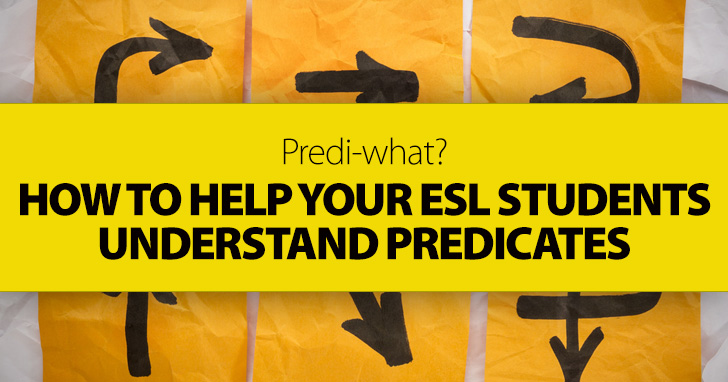How To Teach Sentence Structure: Easy Object Lesson With Zero Preparation


It’s a big word to refer to everything from the verb to the period in a sentence. Sometimes, the predicate is simple, just one word. Other times it contains vast amounts of information about the action, its receiver and doer, when and where something happened, and other important points. Since sentences start with subjects, we usually start by teaching about them, but we can get stuck there and never get to the verb and beyond.
In this article we will talk about what a predicate is, what they contain, and what your students need to know about them.
Every sentence in English has two main parts: the subject and the predicate. The subject of the sentence is the doer of the action. What that subject does is the verb, and the verb is the primary piece of the predicate. No sentence can be without one nor can any predicate. Predicates can be simple, just one word, or they can be many words. Perhaps that is what can make them confusing to ESL students. They don’t fit a straightforward pattern. Here are some of the pieces that may make up a predicate in English.
The one thing every predicate has to have is a verb. But even predicates with nothing other than a verb can be somewhat complicated. Some verb-only predicates may only have one word, while others have many words. That’s because the verb of a predicate can be a simple verb, a verb plus its auxiliaries, or a compound verb (two or more verbs joined by a coordinating conjunction). The following sentences show three very different predicates.
Even at the beginning level, your ESL students should be able to identify the verb in a sentence, and when they do, they are taking the first step to understanding a sentence’s predicate. Often, the verb is the action or movement performed by the subject. Sometimes the verb is a linking verb: am, is, are, was, were, been, or being. If a sentence does not contain a verb, it is not a grammatical sentence and does not have a complete predicate. Making sure each sentence has a verb is something beginning level ESL students should be able to do, and it’s essential to them being able to write and speak grammatical sentences.
Objects often appear in predicates; they tell the reader or listener about the receiver of the verb. Though an object is not essential for every predicate, it is possible for a predicate to have two different types of objects: you probably know and teach these as direct objects and indirect objects. The verb in the sentence determines whether no object, a direct object, or both a direct and indirect object are in the predicate. For some verbs, their objects are optional. For others, the object must be there in order for the verb to make sense. Most often, ESL students start by learning verbs which do not have an object or have an optional object: jump, read, study, etc. These verbs make for the simplest predicates, those with only one word.
Once ESL students are familiar with these simple verbs, they usually move on to verbs which take a direct object: have, see, hit, etc. Verbs that take a direct object give the listener information about the receiver of the action. In such sentences, the predicate includes the verb as well as the direct object.
In the first sentence, cake is the direct object. It is the receiver of the action eat. In the second example, the movie is the direct object. It tells the listener what we saw.
Some English verbs take both a direct and indirect object. The indirect object tells the listener to whom or for whom the verb is performed. Sometimes the indirect object follows to or for and comes after the direct object. Other times, it comes between the verb and the direct object without the use of to or for.
You can help your students identify indirect objects in a sentence by asking them to move the possible indirect object into a phrase starting with to or for. If the sentence still makes sense and the meaning hasn’t changed, that noun is the indirect object. When a verb takes a direct object as well as an indirect object, both of them and the verb make up the predicate of the sentence.
Sometimes a predicate contains either an adjective which describes the subject of the sentence or a noun which describes the subject of the sentence. These words follow a linking verb. When an adjective follows a linking verb and identifies the subject, it is called a predicate adjective. If a noun follows a linking verb and identifies the subject, it is called a predicate nomative.
It is not essential for your students to know these technical terms. What is important is that they are able to identify and label adjectives and nouns that are part of the predicate and be able to tell when those words actually modify the subject of the sentence.
When adjectives, adverbs, and prepositional phrases give the listener more information about the verb in a sentence, they are also considered part of the predicate. Adverbs can appear almost anywhere in a sentence, so your students will see them in various places in a sentence predicate.
In each of these examples, quickly describes the verb and it is part of the predicate of the sentence.
These examples also contain adjectives and a prepositional phrase. These generally come after the verb. In this case, the prepositional phrase is telling the listener where I ran and is thus modifying the verb. Brick is simply describing the house. In these examples, the verb, the adverb, and the prepositional phrase are all part of the predicate, regardless of the order they appear in the sentence. Taken together, they are considered a verb phrase.
Some predicates will also include a dependent clause, which modifies the verb, an object, or the entire sentence. They will begin with a subordinating conjunction. (You can find a list of subordinating conjunctions in English here.)
In each of these examples, the dependent clause is modifying either the object of the verb or the verb itself. Because of this link to the verb, they make up the predicate of each sentence. Your students should eventually be able to use dependent clauses fluently in both their written and spoken English.
By breaking them down into their possible parts and seeing the relationship between those parts, your students should eventually be able to identify them in any English sentence. How do you introduce your students to the predicate?